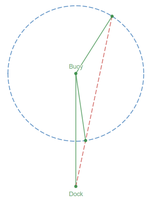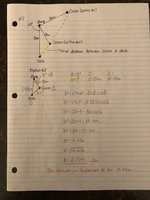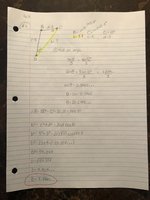CanadianMathMom
New member
- Joined
- Mar 25, 2019
- Messages
- 3

Good morning! Thank you for taking the time to help us. The answer is 7.7km (distance from current canoe and buoy). I am including our work, and the textbook answer. Im not sure if we are missing a step, or have labelled the diagram incorrect. Thanks again!Hello, and welcome to FMH!
Consider the following diagram:
View attachment 11520
The boats starts at the dock, then moves 5 km up to the buoy, and from there it travels an additional 3 km, which could put it anywhere on the circle, however the angle between the boat and the buoy is \(12^{\circ}\) as seen from the dock, which means the boat must also lie along the dotted line. We see there are two possible locations for the boat.
Can you proceed?

Thank you kindly for your help. It is sincerely appreciated. We worked through the problem, and solved with the correct answer. Thanks to all who helped us get through this!!I see two mistakes. First, the 12 degree angle is measured at the dock, not at the turning point. Second, the answer of 7.7 is for option 1, not option 2 (as they assume option 1 is the more natural interpretation). The actual work will be very different from what you show.
By the way, did you notice that, although you stated that the problem illustrates the ambiguous case of the Law of Sines, you used the Law of Cosines, which has no ambiguity? This problem can be solved either by using the Law of Sines, as implied, or by using the Law of Cosines in reverse, which leads to a quadratic equation with two solutions.

